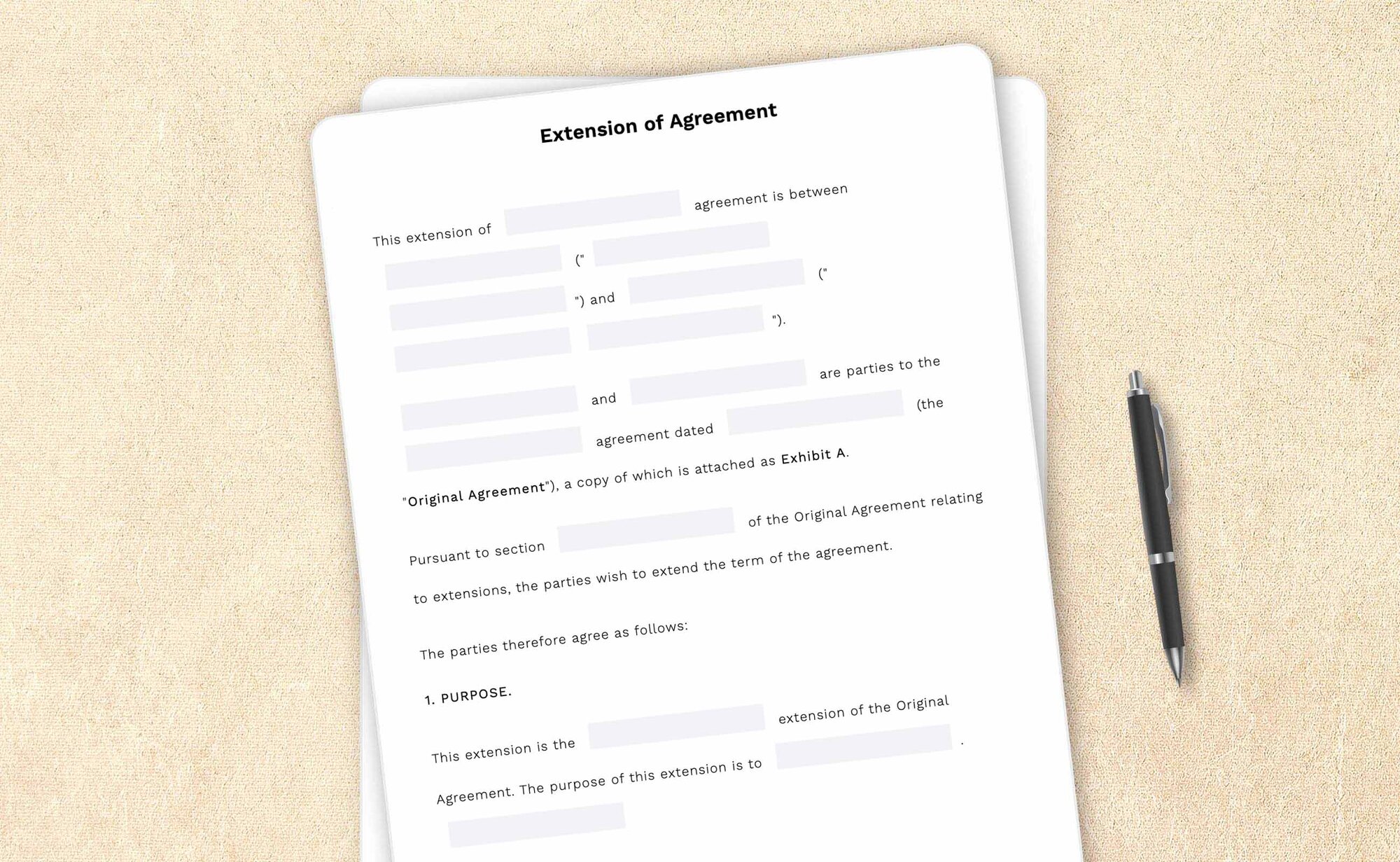This extension of
Pursuant to section
The parties therefore agree as follows:
1. PURPOSE.
This extension is the
2. EXTENSION.
3. INCONSISTENCY.
If there is a conflict between this extension and the Original Agreement, the terms of this extension will govern.
4. AGREEMENT CONTINUANCE.
Except as expressly modified and supplemented by this extension, all other terms and conditions in the Original Agreement remain in full effect and continue to bind the parties.
5. AMENDMENTS.
No amendment to this extension will be effective unless it is in writing and signed by all parties or their authorized representatives.
6. COUNTERPARTS; ELECTRONIC SIGNATURES.
- (a) Counterparts. The parties may execute this extension in any number of counterparts, each of which is an original but all of which constitute one and the same instrument.
- (b) Electronic Signatures. This extension, agreements ancillary to this extension, and related documents entered into in connection with this extension are signed when a party's signature is delivered by facsimile, email, or other electronic medium. These signatures must be treated in all respects as having the same force and effect as original signatures.
7. SEVERABILITY.
If any provision contained in this extension is, for any reason, held to be invalid, illegal, or unenforceable in any respect, that invalidity, illegality, or unenforceability will not affect any other provisions of this extension, but this extension will be construed as if the invalid, illegal, or unenforceable provisions had never been contained in it, unless the deletion of those provisions would result in such a material change so as to cause completion of the transactions contemplated by this extension to be unreasonable.
8. WAIVER.
No waiver of a breach, failure of any condition, or any right or remedy contained in or granted by the provisions of this extension will be effective unless it is in writing and signed by the party waiving the breach, failure, right, or remedy. No waiver of any breach, failure, right, or remedy will be deemed a waiver of any other breach, failure, right, or remedy, whether or not similar, and no waiver will constitute a continuing waiver, unless the writing so specifies.
9. ENTIRE AGREEMENT.
This extension, together with the Original Agreement, constitutes the final agreement of the parties. It is the complete and exclusive expression of the parties' agreement with respect to its subject matter. All prior and contemporaneous communications, negotiations, and agreements between the parties relating to the subject matter of this extension are expressly merged into and superseded by this extension. The provisions of this extension may not be explained, supplemented, or qualified by evidence of trade usage or a prior course of dealings. Neither party was induced to enter this extension by, and neither party is relying on, any statement, representation, warranty, or agreement of the other party except those set forth expressly in this extension. Except as set forth expressly in this extension, there are no conditions precedent to this extension's effectiveness.
10. HEADINGS.
The descriptive headings of the sections and subsections of this extension are for convenience only, and do not affect this extension's construction or interpretation.
11. EFFECTIVENESS.
This extension will become effective when all parties have signed it. The date this extension is signed by the last party to sign it (as indicated by the date associated with that party's signature) will be deemed the date of this extension.
12. NECESSARY ACTS; FURTHER ASSURANCES.
Each party shall use all reasonable efforts to take, or cause to be taken, all actions necessary or desirable to consummate and make effective the transactions this extension contemplates or to evidence or carry out the intent and purposes of this extension.
[SIGNATURE PAGE FOLLOWS]
Each party is signing this agreement on the date stated opposite that party's signature.
| Date: ________________________ | By: __________________________________________________ |
| Name: |
|
| Date: ________________________ | By: __________________________________________________ |
| Name: |
|
[PAGE BREAK HERE]
| EXHIBIT A |
| Attach copy of Original Agreement |
How-to guides, articles, and any other content appearing on this page are for informational purposes only, do not constitute legal advice, and are no substitute for the advice of an attorney.
Extension of agreement: How-to guide
Once a contract is signed, unexpected circumstances may arise, causing parties to struggle to fulfill their obligations within the agreed-upon timeframe. Alternatively, evolving needs may prompt parties to extend their relationship beyond its original scope. In such cases, parties can opt to extend the term of the existing agreement by mutually agreeing to and signing additional documents.
Extensions provide a practical solution for situations where timeframes outlined in the original contract no longer align with current realities. Rather than being bound by outdated terms, parties can use extension agreements to adapt to changing circumstances and ensure continued cooperation. For example, a business arrangement that is proving successful may naturally expire before both parties are ready to part ways. An extension agreement allows them to prolong their collaboration and further develop their partnership.
This article outlines everything about contract extensions, the contract extension process, and how an extended contract helps maintain business relationships.
Key points to consider while creating an extension agreement

1. Reasons for contract extension
Before sitting down to write, decide exactly what your goals are for the extension. Try to capture the revisions without invalidating or confusing the existing contract. Before drawing a new contract, clarify the following:
- Will the extension have a set term?
- Will it continue indefinitely?
- Are there other changes to the contract that need to be made?
2. Review both the existing contract and contract extension agreement
Allow each party to review the existing contract and the extension agreement. The parties involved should thoroughly check the existing terms and the new terms of the contract. It'll prevent the parties from coming in the future and raise claims that they didn't understand certain new terms or clauses in the new contract.
They should ensure the contract extension agreement contains all the provisions the companies want to include in the new deal. Reiterating the conditions mentioned in the original document is a good practice to ensure clarity.
3. Validity of the terms of the contract
The terms of your original contract or existing contract are still in effect until the extension agreement is completed and signed. Ensure both parties continue to perform their obligations under the original agreement.
4. Sign two new contracts
The parties involved must sign two copies of the extension agreement to complete the entire process. One copy of the new contract is kept by one party, and the second one is for the other party.
Keep your copy of the signed extension agreement with the original contract. Once the extension agreement is drafted and signed, it is part of the original agreement and should be treated accordingly.
5. Need for witness
It's a good idea to involve a witness or notary during the agreement's signing to avoid future challenges regarding the arrangement's validity.
For extension agreements where there are changes to a lot of provisions, having an attorney to figure out helps. You can also use their expertise in drafting contract documents suiting your needs.
Important clauses of a contract extension agreement

The following instructions will help you understand the terms of your extension agreement.
1. Introduction
This section identifies the document as an extension of an original contract. Herein, provide the details of the parties involved and the extension date. The parties must be the same as those who signed the original document (unless one of the new signers is an agent of the same company that initially signed). They should also have the same designations (i.e., party one is still party one, party two is still party two). Please give the date of the original agreement, when it was signed, and the end date (i.e., the original end date).
2. Recitals
This part explains what is being changed in the extension agreement. Put in the effective date of the original agreement and the date on which the current terms end. You must also provide a signed copy of the original contract.
3. Purpose of the extension
Use this section to explain what you hope to accomplish with your extension agreement and why you feel it is necessary. If you're extending the original contract for the first time, you must also mention that. If the contract renewal happens for a second time or more, provide the exact number of times it was extended.
4. Extension of agreement
In this part, you must give the period you want to extend the contract. You can extend the term of the original agreement to a new specific date. You can make this as long or as short as you want. It doesn't have to be the same length as the term of the original contract. Write in the length of the new term and the date on which that term will end.
There is also a provision where you needn't provide a new end date for the agreement. Instead, the agreement will continue indefinitely until the parties terminate it or it terminates on its own under state or local regulations.
5. Inconsistency
It notes that if there is a conflict between the language used in the extension agreement and the language in the original agreement, the original agreement's language will be the final word on the question.
6. Continuation of agreement
This clause serves as an "affirmation" of the original agreement. In other words, the only change in the original contract is the term or period when the new agreement will last. All other terms and conditions of the original contract remain effective.
7. Entire agreement
Here, the parties agree that the document they're signing (when taken together with the original agreement) is "the agreement" about the issues involved.
8. Modification
It indicates that any changes to the contract extension will be in writing and signed by both parties.
9. Severability
This clause protects the terms of the extension as a whole, even if one part is later invalidated.
10. Counterparts; electronic signatures
This provision allows the parties to sign the extension agreement using electronic devices or signatures.
The clauses mentioned above are some of the key provisions that could be found in a contract extension agreement.
Use LegalZoom’s extension of agreement template to draft your documents
A written contract minimizes confusion, misunderstanding, and error and sets forth the parties' expectations and fulfillment obligations. Use LegalZoom's extension agreement template to create professional agreements easily and quickly. Just provide answers for the questionnaire, complete the form, and download the document.
Our agreement templates could also be customized easily to suit your needs. With the help of a rich editor, you can add texts and images to your document wherever you need them.
Frequently asked questions
What’s an extension of agreement?
An extension agreement or extension contract is a document that prolongs the duration or modifies the terms of an existing contract. It allows parties to continue their agreement beyond the original expiration date or adjust the terms to accommodate changing circumstances.
This extension typically requires mutual consent from all parties involved and may involve signing additional documents to formalize the changes. Extension agreements are commonly used to accommodate unforeseen circumstances and changing needs or to ensure continued cooperation between parties.
What are the essential details required to fill an extension agreement?
Here's the information you'll need to have handy to complete your extension agreement:
- Who it's coming from: Have the name and contact information of the party sending the contract extension document
- Who it's going to: Keep the information of the party to whom this document is being sent
- Subject matter: Explain why you're extending the original contract
- Dates: Know when this agreement takes effect and if and when it ends
